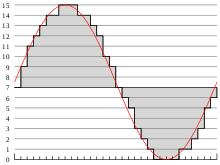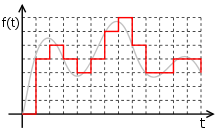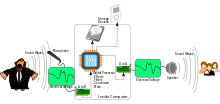- Digital audio
-
"Digital music" redirects here. For a kind of modern music composed by digital means, see electronic music.
Digital audio is sound reproduction using pulse-code modulation and digital signals. Digital audio systems include analog-to-digital conversion (ADC), digital-to-analog conversion (DAC), digital storage, processing and transmission components. A primary benefit of digital audio is in its convenience of storage, transmission and retrieval.
Contents
Overview of digital audio
 Sampling and 4-bit quantization of an analog signal (red) using Pulse-code modulation
Sampling and 4-bit quantization of an analog signal (red) using Pulse-code modulation
Digital audio has emerged because of its usefulness in the recording, manipulation, mass-production, and distribution of sound. Modern distribution of music across the Internet via on-line stores depends on digital recording and digital compression algorithms. Distribution of audio as data files rather than as physical objects has significantly reduced the cost of distribution.
In an analog audio system, sounds begin as physical waveforms in the air, are transformed into an electrical representation of the waveform, via a transducer (for example, a microphone), and are stored or transmitted. To be re-created into sound, the process is reversed, through amplification and then conversion back into physical waveforms via a loudspeaker. Although its nature may change, analog audio's fundamental wave-like characteristics remain the same during its storage, transformation, duplication, and amplification.
Analog audio signals are susceptible to noise and distortion, unavoidable due to the innate characteristics of electronic circuits and associated devices. In the case of purely analog recording and reproduction, numerous opportunities for the introduction of noise and distortion exist throughout the entire process. When audio is digitized, distortion and noise are introduced only by the stages that precede conversion to digital format, and by the stages that follow conversion back to analog.
The digital audio chain begins when an analog audio signal is first sampled, and then (for pulse-code modulation, the usual form of digital audio) it is converted into binary signals—‘on/off’ pulses—which are stored as binary electronic, magnetic, or optical signals, rather than as continuous time, continuous level electronic or electromechanical signals. This signal may then be further encoded to allow correction of any errors that might occur in the storage or transmission of the signal, however this encoding is for error correction, and is not strictly part of the digital audio process. This "channel coding" is essential to the ability of broadcast or recorded digital system to avoid loss of bit accuracy. The discrete time and level of the binary signal allow a decoder to recreate the analog signal upon replay. An example of a channel code is Eight to Fourteen Bit Modulation as used in the audio Compact Disc (CD).
Conversion process
A digital audio system starts with an ADC that converts an analog signal to a digital signal.[note 1] The ADC runs at a sampling rate and converts at a known bit resolution. For example, CD audio has a sampling rate of 44.1 kHz (44,100 samples per second) and 16-bit resolution for each channel. For stereo there are two channels: 'left' and 'right'. If the analog signal is not already bandlimited then an anti-aliasing filter is necessary before conversion, to prevent aliasing in the digital signal. (Aliasing occurs when frequencies above the Nyquist frequency have not been band limited, and instead appear as audible artifacts in the lower frequencies).
The digital audio signal may be stored or transmitted. Digital audio storage can be on a CD, a digital audio player, a hard drive, USB flash drive, CompactFlash, or any other digital data storage device. The digital signal may then be altered in a process which is called digital signal processing where it may be filtered or have effects applied. Audio data compression techniques — such as MP3, Advanced Audio Coding, Ogg Vorbis, or FLAC — are commonly employed to reduce the file size. Digital audio can be streamed to other devices.
The last step is for digital audio to be converted back to an analog signal with a DAC. Like ADCs, DACs run at a specific sampling rate and bit resolution but through the processes of oversampling, upsampling, and downsampling, this sampling rate may not be the same as the initial sampling rate.
History of digital audio use in commercial recording
Pulse-code modulation was invented by British scientist Alec Reeves in 1937[1] and was used in telecommunications applications long before its first use in commercial broadcast and recording. Commercial digital recording was pioneered in Japan by NHK, and Nippon Columbia (a.k.a. Denon) in the 1960s. The first commercial digital recordings were released in 1971.[2]
The BBC also began experimenting with digital audio in the 1960s. By the early 1970s they had developed a 2-channel recorder and in 1972 they deployed a digital audio transmission system linking their broadcast center to their remote transmitters.[2]
The first 16-bit PCM recording in the United States was made by Thomas Stockham at the Santa Fe Opera in 1976 on a Soundstream recorder. In 1978, an improved version of the Soundstream system was used by Telarc to produce several classical recordings. At the same time 3M was well along in development of their digital multitrack recorder based on BBC technology. The first all-digital album recorded on this machine was Ry Cooder's "Bop 'Til You Drop" which was released in 1979. In a crash program started in 1978, British record label Decca developed their own 2-track digital audio recorders. Decca released the first European digital recording in 1979.[2]
Helped along by introduction of popular digital multitrack recorders from Sony and Mitsubishi in the early 1980s, digital recording was soon embraced by the major record companies. With the introduction of the CD by Sony and Philips in 1982, digital audio was embraced by consumers as well.[2]
Digital audio technologies
Digital audio broadcasting
- Digital Audio Broadcasting (DAB)
- HD Radio
- Digital Radio Mondiale (DRM)
- In-band on-channel (IBOC)
Storage technologies:
- Digital audio player
- Digital Audio Tape (DAT)
- Compact Disc (CD)
- Hard disk recorder
- DVD Audio
- MiniDisc
- Super Audio CD
- Various audio file formats
Digital audio interfaces
Audio-specific interfaces include:
- AC'97 (Audio Codec 1997) interface between Integrated circuits on PC motherboards
- Intel High Definition Audio A modern replacement for AC'97
- ADAT interface
- AES3 interface with XLR connectors
- AES47, Professional AES3-style digital audio over Asynchronous Transfer Mode networks
- I²S (Inter-IC sound) interface between Integrated circuits in consumer electronics
- MADI Multichannel Audio Digital Interface
- MIDI low-bandwidth interconnect for carrying instrument data; cannot carry sound but can carry digital sample data in non-realtime
- S/PDIF, either over coaxial cable or TOSLINK
- TDIF, TASCAM proprietary format with D-sub cable
- A2DP via Bluetooth
Naturally, any digital bus (e.g., USB, FireWire, and PCI) can carry digital audio. Also, several interfaces are engineered to carry digital video and audio together, including HDMI and DisplayPort.
In professional architectural or installation applications, many digital audio networking protocols and interfaces exist.
See also
- Analog recording vs. digital recording
- Audio signal processing
- Digital audio editor
- Digital audio workstation
- Dither
- Harmonically enhanced digital audio
- Jitter
- Mind the gap, an early application of digital audio
- Music sequencer
- Noise shaping
- Nyquist–Shannon sampling theorem
- Quantization (signal processing)
- Software synthesizer
- Continuously variable slope delta modulation
- 2000s in music industry
References
- ^ Genius Unrecognised, BBC, 2011-03-27, http://www.bbc.co.uk/programmes/b00zs7v5, retrieved 2011-03-30
- ^ a b c d Fine, Thomas (2008). Barry R. Ashpole. ed. "The Dawn of Commercial Digital Recording". ARSC Journal (Ted P. Sheldon). http://www.aes.org/aeshc/pdf/fine_dawn-of-digital.pdf. Retrieved 2010-05-02.
- Borwick, John, ed., 1994: Sound Recording Practice (Oxford: Oxford University Press)
- Ifeachor, Emmanuel C., and Jervis, Barrie W., 2002: Digital Signal Processing: A Practical Approach (Harlow, England: Pearson Education Limited)
- Rabiner, Lawrence R., and Gold, Bernard, 1975: Theory and Application of Digital Signal Processing (Englewood Cliffs, New Jersey: Prentice-Hall, Inc.)
- Watkinson, John, 1994: The Art of Digital Audio (Oxford: Focal Press)
- Bosi, Marina, and Goldberg, Richard E., 2003: Introduction to Digital Audio Coding and Standards (Springer)
Notes
- ^ Some audio signals such as those created by digital synthesis originate entirely in the digital domain, in which case analog to digital conversion does not take place.
Digital systems Components Theory Applications - Digital audio
- Digital photography
- Digital video
- Electronic literature
Categories:
Wikimedia Foundation. 2010.


